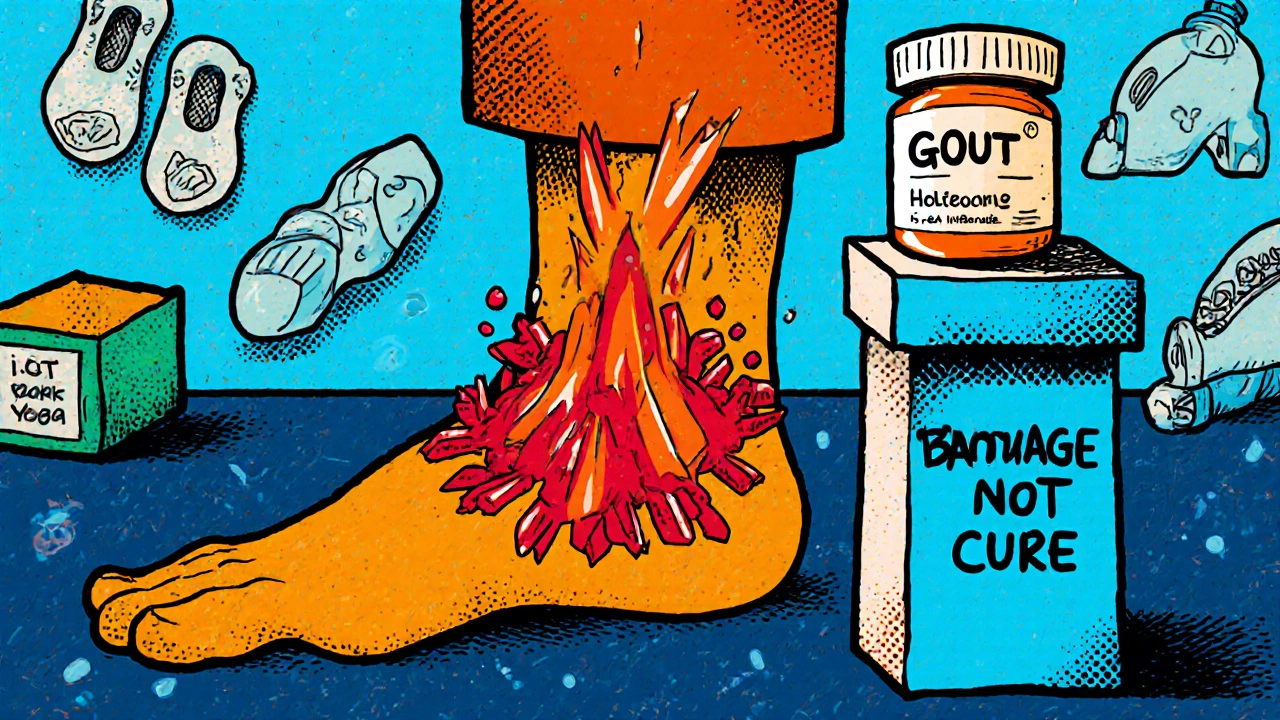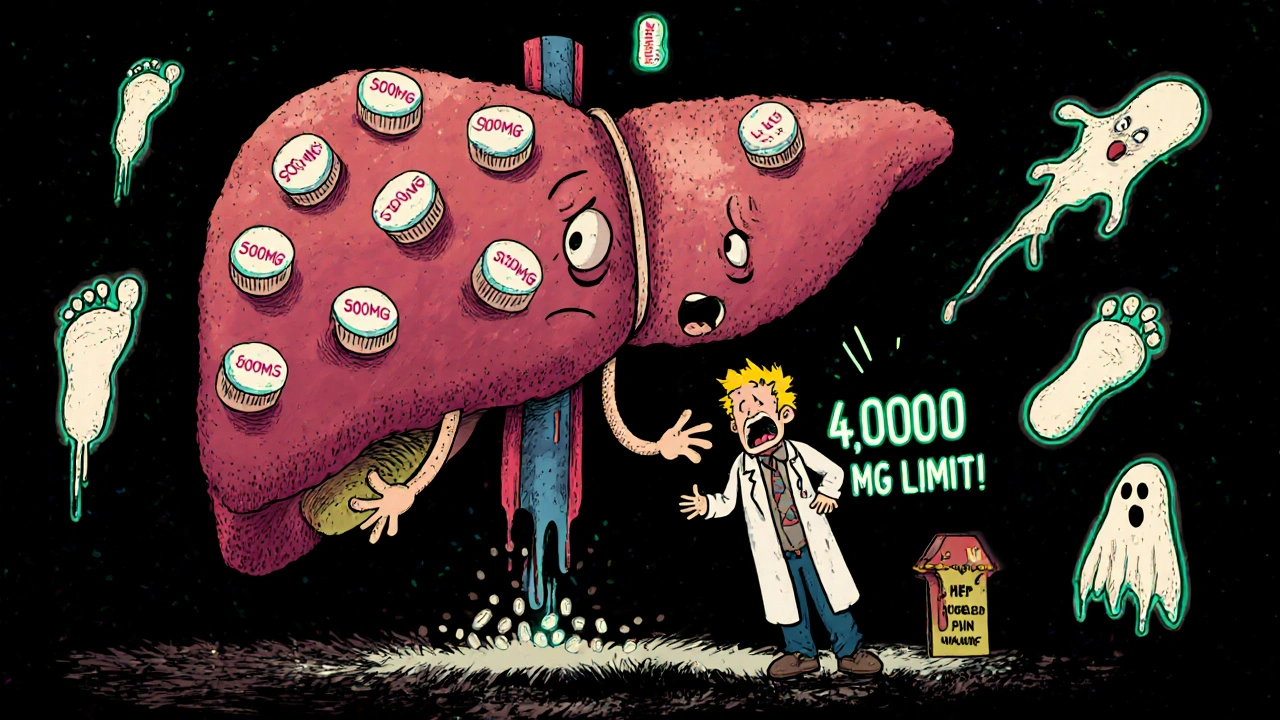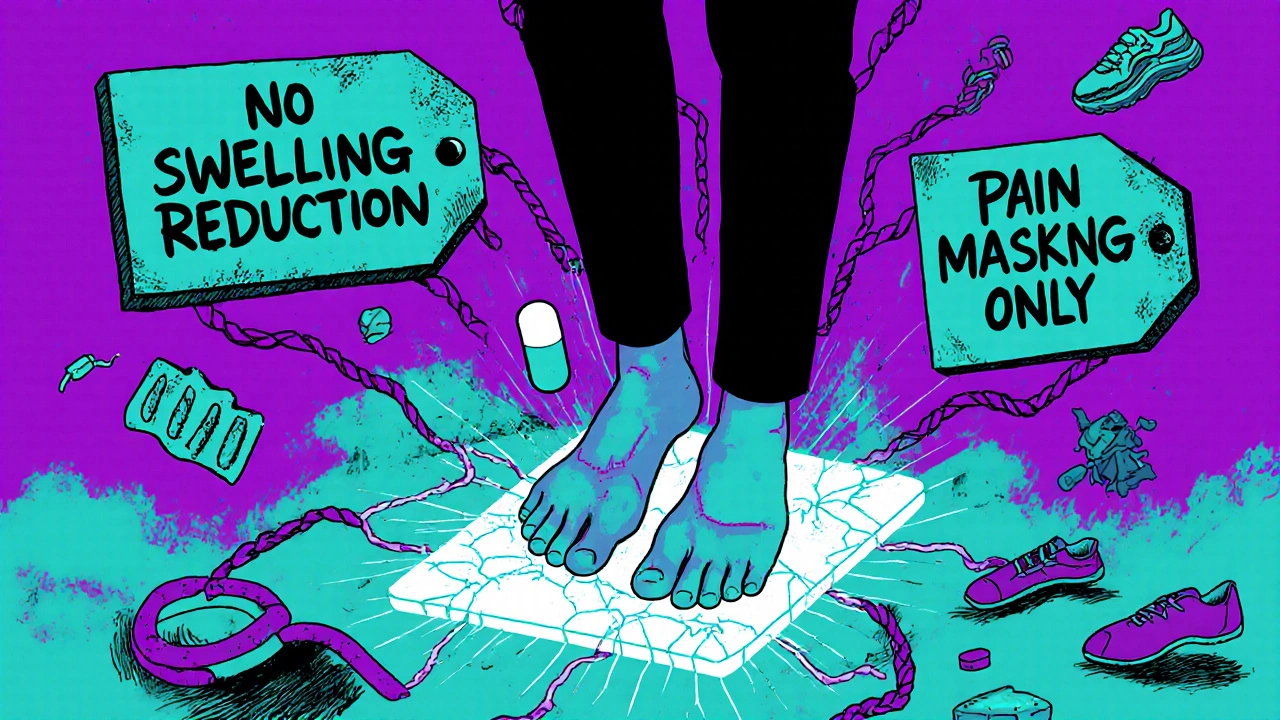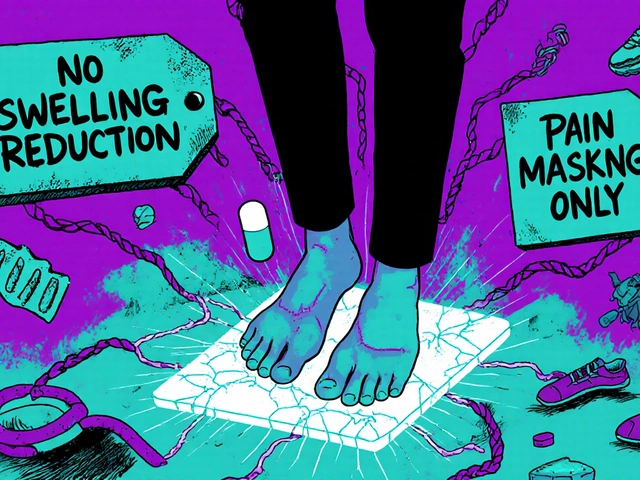Foot pain can come out of nowhere - a long walk, new shoes, or just waking up with a throbbing arch. Many people reach for acetaminophen first because it’s in nearly every medicine cabinet. But does it actually work for foot pain? The answer isn’t simple. Acetaminophen doesn’t reduce swelling, and foot pain often comes from inflammation. So while it might dull the ache, it won’t fix what’s causing it.
How acetaminophen actually works
Acetaminophen, also known as paracetamol, is a painkiller that works in the brain, not at the site of injury. Unlike ibuprofen or naproxen, it doesn’t block the enzymes that cause inflammation. That’s why it’s not called an NSAID. It reduces your perception of pain, but it doesn’t touch redness, heat, or swelling. If your foot pain is from plantar fasciitis, gout, or a sprained ligament - conditions with real inflammation - acetaminophen will only mask the symptom, not treat the cause.
Studies show acetaminophen is about as effective as a placebo for joint pain when inflammation is involved. A 2022 review in The BMJ looked at over 20 trials on osteoarthritis and found acetaminophen offered only minimal relief, especially in moderate to severe cases. Foot pain from arthritis or overuse often fits this pattern.
When acetaminophen might help
There are times when acetaminophen makes sense. If your foot pain is mild, not linked to swelling, and you can’t take NSAIDs - maybe because of stomach issues, kidney problems, or high blood pressure - then acetaminophen is a safer choice. It’s also useful if you’re taking blood thinners, since NSAIDs can increase bleeding risk.
For example, someone with mild arch pain from standing all day at work might find relief with 500 mg of acetaminophen every 6 hours. It won’t make the arch heal faster, but it can make the day bearable. Same goes for nerve-related foot pain, like mild diabetic neuropathy, where inflammation isn’t the main driver.
What acetaminophen won’t fix
Foot pain from these conditions usually needs more than acetaminophen:
- Plantar fasciitis - needs stretching, supportive shoes, and sometimes physical therapy
- Gout - requires anti-inflammatory meds like colchicine or NSAIDs to calm the flare
- Tendonitis - responds to rest, ice, and compression, not just painkillers
- Frozen foot syndrome (from prolonged cold exposure) - needs warming and medical attention
- Stress fractures - need imaging and time to heal, not just pain relief
Using acetaminophen for these can give a false sense of security. You might keep walking on a stress fracture because the pain is duller, and end up making it worse.

Dosage and safety limits
The maximum safe daily dose of acetaminophen is 4,000 mg for most adults - that’s eight 500 mg tablets. But many people don’t realize how easy it is to go over that limit. Cold medicines, sleep aids, and combo pain relievers often contain acetaminophen too. Taking Tylenol for your foot and then a cold tablet later? That’s how liver damage happens.
People with liver disease, heavy drinkers, or those on certain epilepsy or TB medications should talk to a doctor before using it. Even one extra tablet a day over weeks can quietly stress the liver. There’s no warning sign until it’s too late.
What to try instead
If acetaminophen isn’t doing enough, here are better options:
- NSAIDs like ibuprofen (200-400 mg every 6-8 hours) - reduce both pain and swelling
- Ice packs - 15 minutes, 3 times a day, for acute pain
- Orthotic inserts - support for flat feet or high arches
- Stretching routines - calf and plantar fascia stretches take 5 minutes and help daily
- Proper footwear - no more flip-flops for walking more than 10 minutes
For persistent pain, physical therapy is often the most effective long-term fix. A 2023 study in the Journal of Foot and Ankle Research found that 80% of people with chronic plantar fasciitis improved significantly after 8 weeks of targeted exercises - far better than any pill.

When to see a doctor
Don’t wait if you have:
- Pain that wakes you up at night
- Swelling, redness, or warmth in the foot
- Numbness or tingling
- Pain after an injury, even if you think it’s minor
- Pain that doesn’t improve after 2 weeks of home care
These aren’t just "bad feet." They could be signs of infection, nerve damage, or a fracture. Delaying care can turn a simple fix into a long recovery.
Bottom line
Acetaminophen can help with mild, non-inflammatory foot pain - especially if you can’t take NSAIDs. But it’s not a solution. It’s a temporary buffer. If your foot hurts because of inflammation, injury, or biomechanical issues, you need more than a pill. Real relief comes from addressing the root cause: better shoes, stretching, rest, or professional care.
Don’t let acetaminophen become your only tool. It’s a bandage, not a cure.
Can acetaminophen reduce swelling in the foot?
No, acetaminophen does not reduce swelling. It only helps with pain perception in the brain. For swelling - like in plantar fasciitis, gout, or sprains - you need an anti-inflammatory like ibuprofen, ice, or rest.
Is acetaminophen safer than ibuprofen for foot pain?
It’s safer for your stomach and kidneys, but not necessarily safer overall. Ibuprofen reduces inflammation, which often causes foot pain. Acetaminophen won’t help if inflammation is the issue. If you have liver problems or drink alcohol, acetaminophen is riskier. Choose based on your health history, not just convenience.
How long should I take acetaminophen for foot pain?
Don’t use it for more than 10 days without seeing a doctor. If your foot pain lasts longer than two weeks, it’s not getting better on its own. Long-term use increases liver damage risk, even at normal doses. Use it only as a short-term bridge while you address the real cause.
Can I take acetaminophen with other painkillers?
Only if you’re sure they don’t contain acetaminophen already. Many cold, flu, and sleep meds include it. Taking two products with acetaminophen can easily push you over the 4,000 mg daily limit. Always check the ingredients list - it’s on the back of the box.
What’s the best way to use acetaminophen for foot pain?
Take 500 mg every 6 hours, with food, and never exceed 4,000 mg in 24 hours. Pair it with ice, rest, and supportive shoes. Don’t use it to keep walking on a painful foot - that can make the injury worse. Use it to get through the day, not to ignore the problem.


Acetaminophen is fine for mild aches, but if your foot's swollen or hot to the touch, you're just masking the fire with a wet napkin. NSAIDs or ice are the real moves here. I've seen too many people keep walking on plantar fasciitis because Tylenol made it "bearable"-then end up in PT for months. Don't be that person.
Been using acetaminophen for my arch pain after long shifts. Works okay but I started doing calf stretches every morning. Big difference. No more pills needed after 3 weeks.
so tylenol dont reduce swelling huh guess thats why my foot stopped hurting after i took 8 pills in a day lol jk but seriously why do people think painkillers fix stuff
There’s something deeply human about reaching for a pill when your body screams at you. We’ve been taught to silence pain instead of listening to it. Acetaminophen isn’t evil-it’s just a quiet whisper in a world that demands silence. But your foot? It’s screaming for rest, for support, for care. The pill just lets you ignore the message until it becomes a scream you can’t unhear.
Pharmacologically, acetaminophen’s mechanism of action is distinct from NSAIDs due to its central COX inhibition without peripheral anti-inflammatory effects. This makes it suboptimal for inflammatory etiologies of foot pain such as plantar fasciitis or gout, where local prostaglandin synthesis drives symptomatology.
They don’t want you to know this but acetaminophen is secretly a tool of Big Pharma to keep you dependent while they sell you expensive PT sessions. Meanwhile, the real cure? Barefoot walking on grass. That’s what they banned in 1972. I’ve got the declassified docs. 😈
EVERYONE is being lied to. The FDA knows acetaminophen causes foot pain, not the other way around. They just don’t want you to know that the liver damage is a distraction tactic. I used to take it for my heel pain, then I noticed my toes turned purple. I went to the ER and they laughed. They know. They ALL KNOW. I’ve been documenting this for 11 years. Someone needs to listen.
I’ve had plantar fasciitis for 2 years. Tylenol helped a little. Ice and orthotics fixed it. No drama.
Thank you for sharing this with such clarity. Many people don’t realize that pain is a signal, not an enemy. It’s important to honor our bodies by addressing root causes rather than masking symptoms. This post is a gift to anyone who’s been told to just "take something and move on." I’ve seen elders in my community suffer needlessly because they were never taught how to care for their feet properly. Simple stretches, supportive shoes, and rest-these are the real medicine.
While acetaminophen exhibits a favorable gastrointestinal safety profile compared to NSAIDs, its hepatic metabolism via CYP450 enzymes renders it contraindicated in patients with pre-existing hepatic impairment or concomitant alcohol use. The narrow therapeutic index necessitates vigilant monitoring of daily dosing, particularly in polypharmacy regimens.
i took tylenol for my foot for 3 weeks straight and my liver enzymes went crazy. doctor said i was lucky. dont be dumb like me.
you people are overthinking this just put your foot up and drink water
Acetaminophen is a controlled substance disguised as an OTC medication. The FDA’s 4,000mg limit is a lie. The real limit is 2,000mg-and only if you’re white, male, and under 40. The rest of us? We’re statistically invisible until our livers fail. This is systemic medical negligence. I’ve filed 17 FOIA requests. No one responds. That’s not an accident.